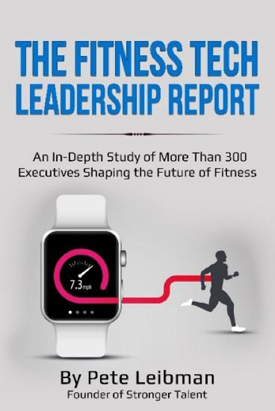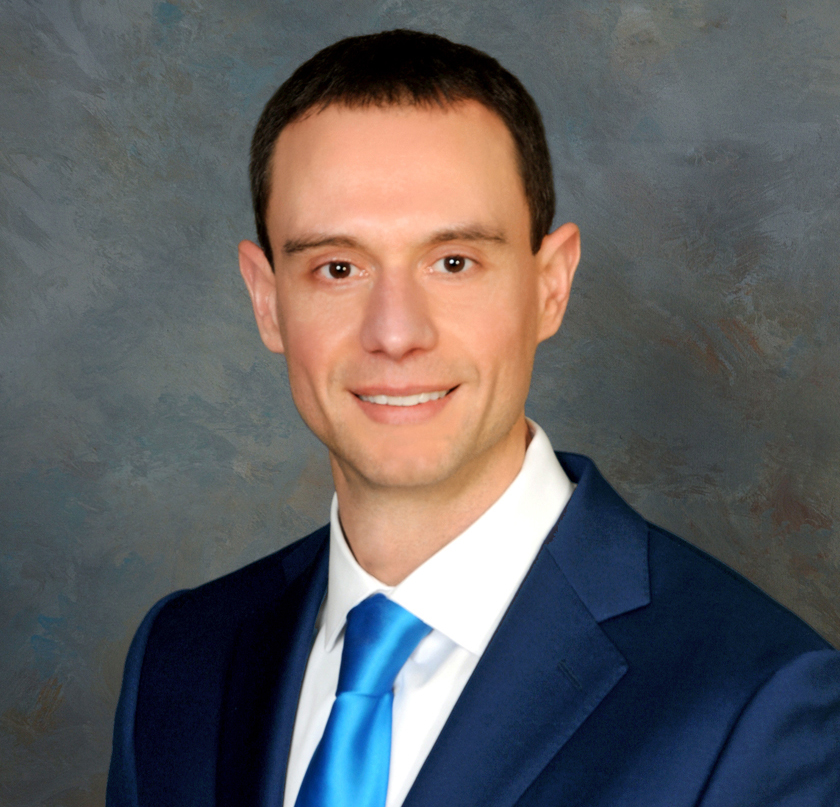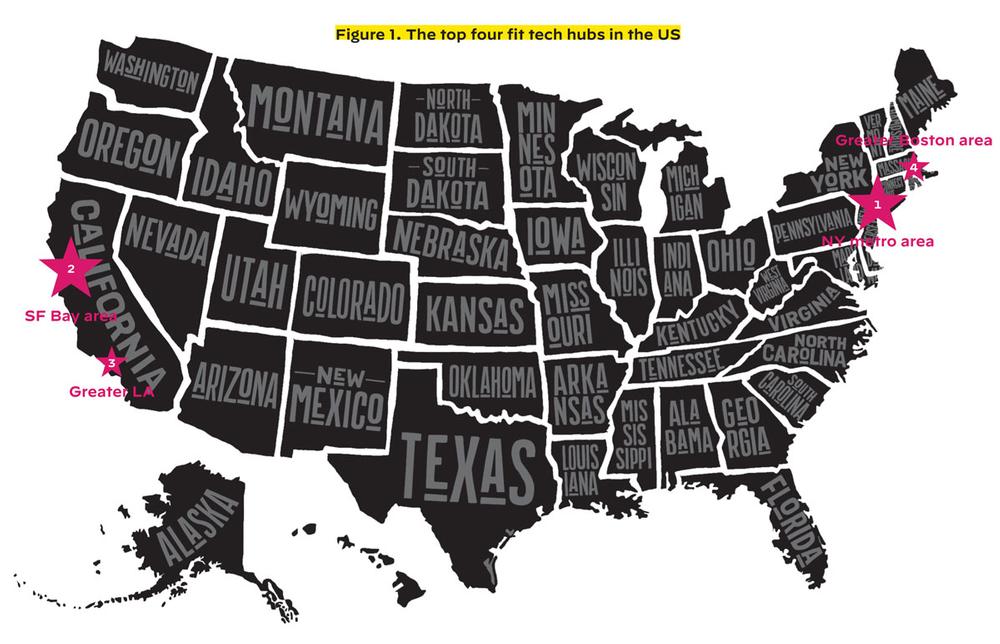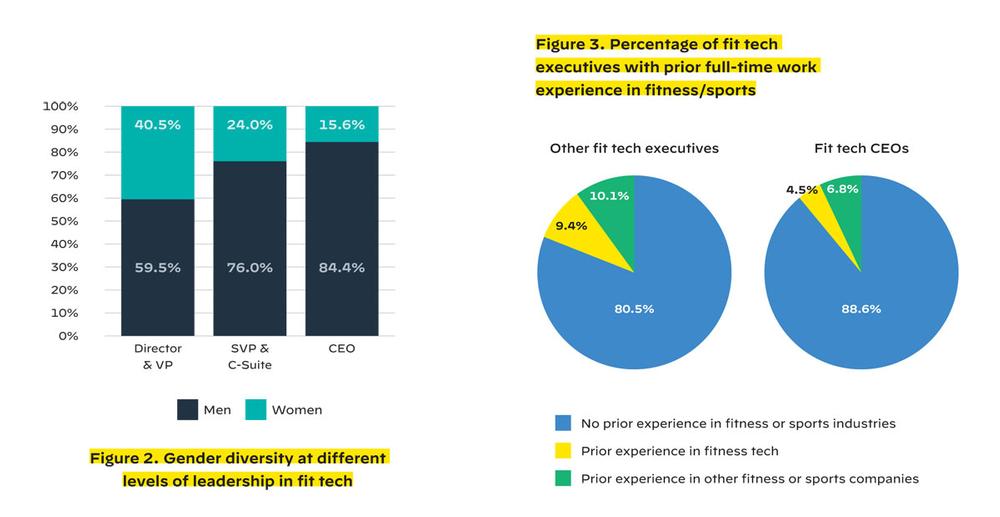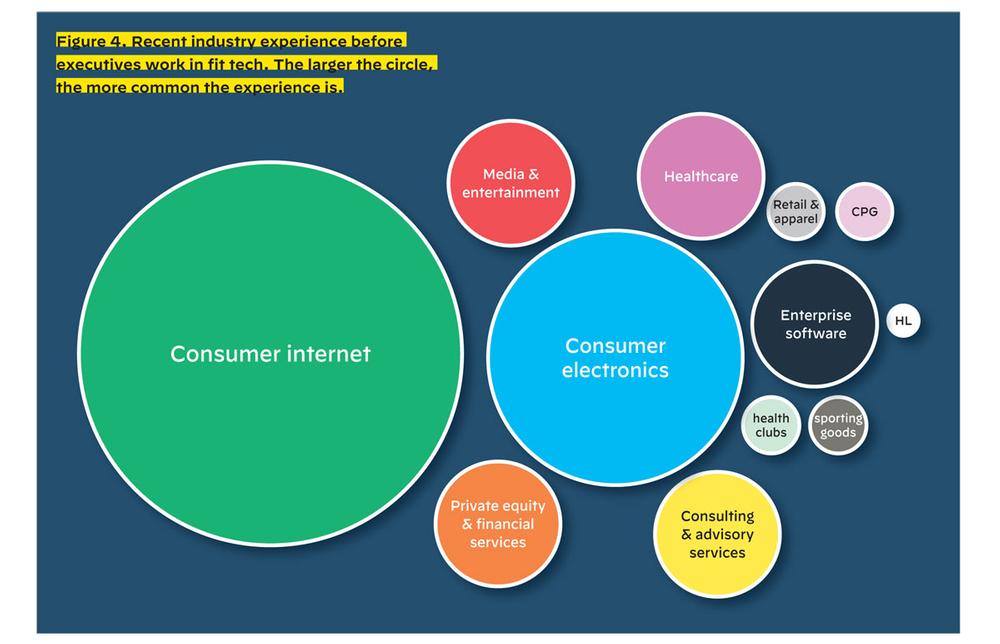For the Fitness Tech Leadership Report we analysed the backgrounds of fit tech CEOs, other C-suite executives (i.e. CFO, COO, CTO, CMO, CHRO, etc.), senior vice presidents, vice presidents, senior directors and directors. The leaders in our study represent a variety of functions, including sales, marketing, strategy, business development, product management, technology, finance, operations and human resources.
Our study focused exclusively on executives based in the US, although a small percentage of the executives in our study work for companies that are headquartered outside the US.
At the time of our study, the executives that we analysed were employed by more than 50 of the world’s top fit tech companies, across the fit tech sub-categories of fitness wearables, connected fitness, streaming fitness and fitness apps. This group of companies includes:
• Fit tech start-ups of various sizes and stages
• Fit tech companies that are more mature and/or publicly-traded
• Fit tech business units inside of larger organisations
• The top four fit tech hubs in the US
Our research indicates that there are four primary hubs in the US where the large majority of fit tech companies and executives are based. Over 75 per cent of the executives in our study were based in one of these four areas. In addition, over 68 per cent of the companies in our study have their global headquarters or US headquarters in one of these areas:
1. New York Metro Area
2. San Francisco Bay Area
3. Greater Los Angeles Area
4. Greater Boston Area
Fewer than 25 per cent of executives analysed (in total) were based in all other US cities combined.
Men greatly outnumber women in fit tech
Our research indicates that men greatly outnumber women in fit tech, especially as you move up in many companies. Over 68 per cent of all executives identified in our study were men.
Women only made up about 40 per cent of the directors, senior directors and vice presidents. In addition, less than 25 per cent of C-Suite and SVP positions were occupied by women, and less than 16 per cent of CEO positions were occupied by women.
Our findings on gender diversity are pretty consistent with McKinsey’s Women in the Workplace 2019, the most comprehensive, annual study of the state of women in corporate America.
Most fit tech executives don’t come from fitness or sports
Our research indicates that the large majority of fit tech executives had no prior full-time work experience in the fitness or sports industries before joining their current fit tech company. Over 88 per cent of the CEOs in our study (most of whom are also founders) had no prior full-time work experience in fitness or sports. As for the other (non-CEO) executives in our study, over 80 per cent had no prior full-time work experience in fitness or sports.
Where do executives usually work before fitness tech?
We analysed which companies and industries the executives in our study had worked in during the last ten years (including their current employer).
Our study found that fit tech executives come from a wide variety of industries. However, two industries definitely stand out as the most common:
1. Consumer internet: This includes e-commerce businesses, mobile apps (including fitness apps), and social media platforms.
2. Consumer electronics: This includes companies that make devices used for communications, recreation, and entertainment. Companies that make fitness hardware (i.e. fitness trackers and connected fitness products) also fit into the broader category of consumer electronics.
There was a significant drop-off in the frequency of industry experience after these two industries. The next five most common industries were media and entertainment, healthcare, enterprise software, consulting and advisory services, and financial services and private equity.
Only about five per cent of executives had recent full-time work experience in health clubs or boutique fitness and only about five per cent had recent full-time work experience in sporting goods or fitness equipment. Other industries that showed up but were not common include retail and apparel, consumer packaged goods (CPG), and hospitality and leisure (HL).
Recommendations
Fit tech is poised for significant growth and competition in the years to come, especially as tech giants such as Google, Apple and Amazon increase their participation in the market. Companies that are able to attract and retain the best people will be well-positioned for future success, while companies that fail to do so will struggle to survive.
While our full report provides much more extensive recommendations, here are three quick tips, based on our research and experience:
1. Make diversity a bigger priority
Diversity is not only a social and moral cause. Research has shown that a more diverse workforce is also correlated with higher employee engagement scores, along with greater profitability.
2. Expand your recruiting geography
The shutdown has made many people more comfortable with remote work. In addition to local recruiting, target top performers in regions where your company does not have any physical office locations. If your company presents a compelling value proposition, you might attract some great people.
3. Pursue candidates from new talent pools
Many fitness tech companies recruit primarily from talent pools that are fairly narrow. However, there is tremendous value in expanding your efforts. Identify some additional industries, categories and companies where your company will begin searching for talent as well.









